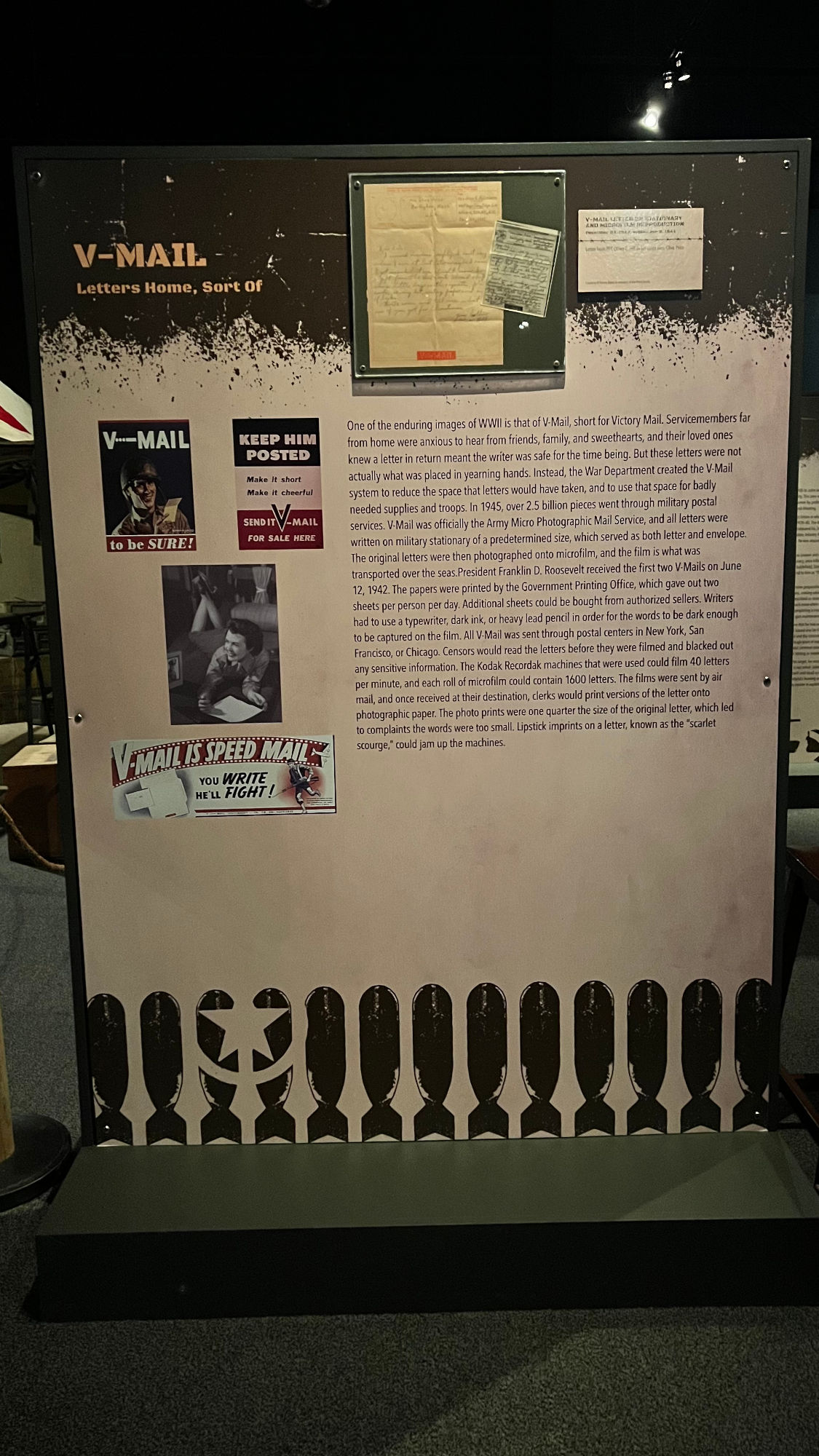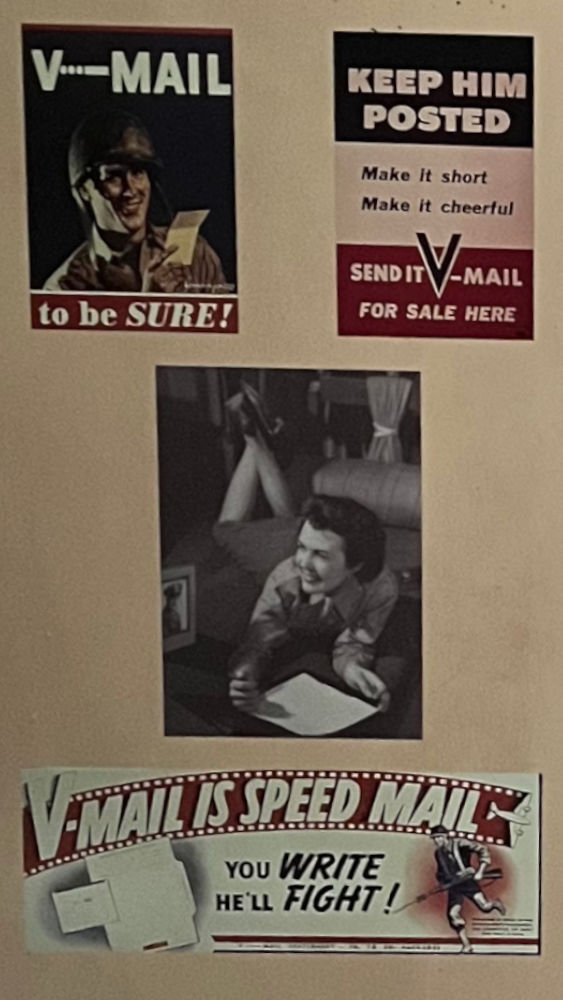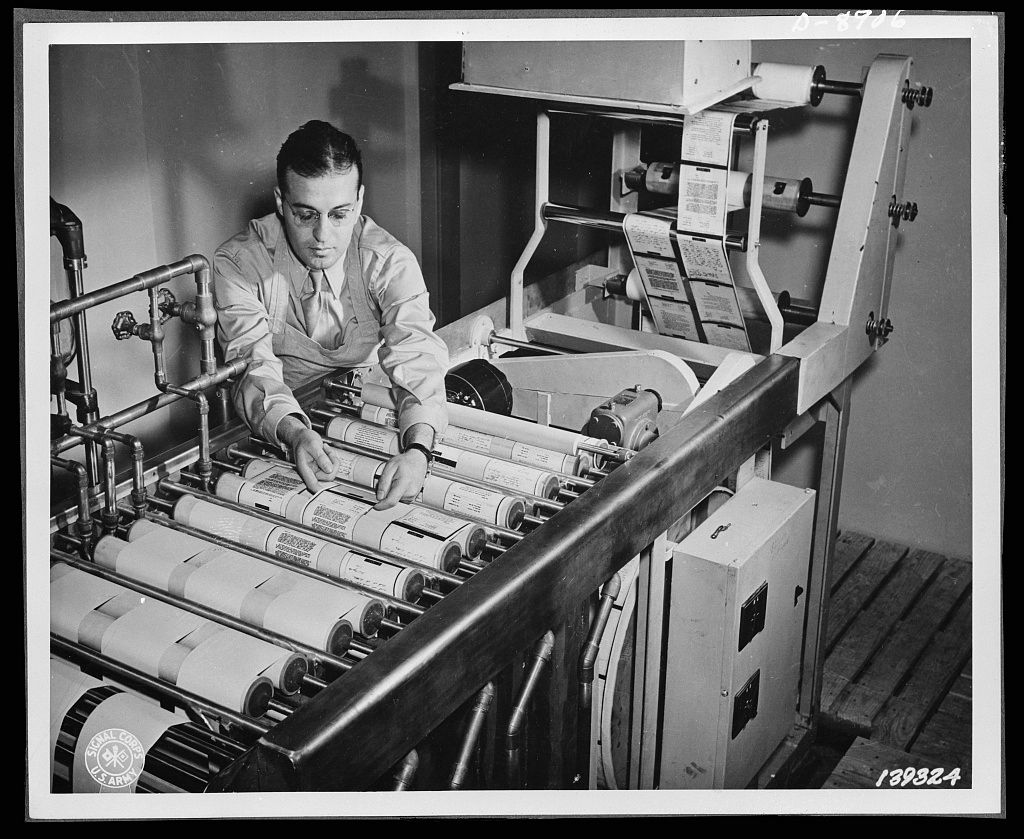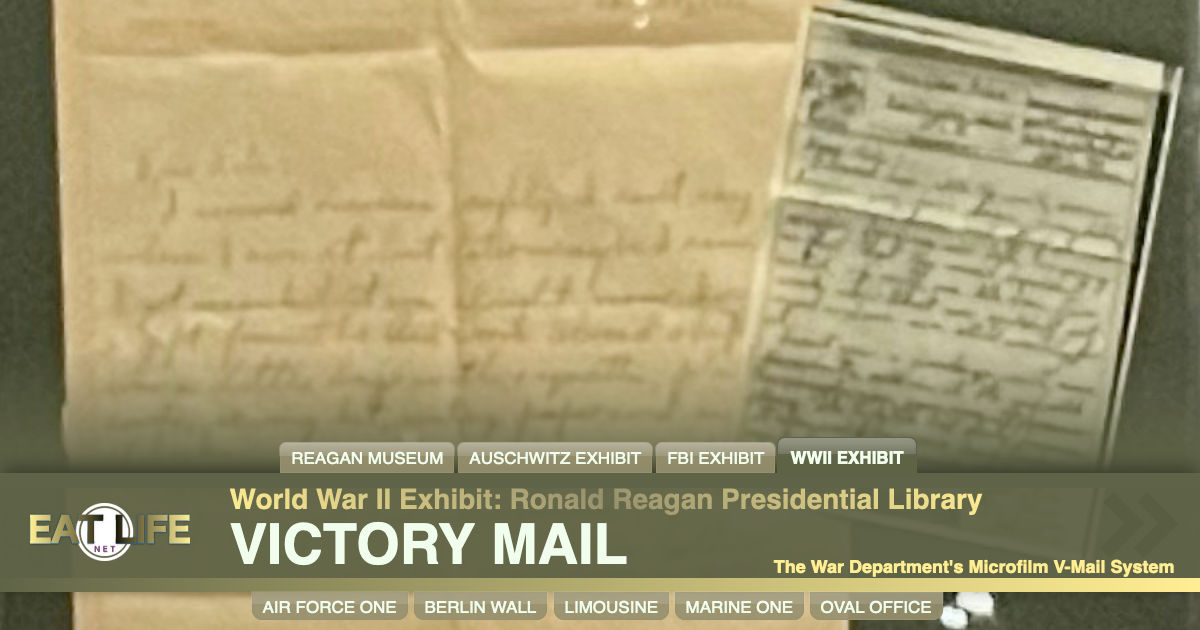The War Department created the V-Mail system to reduce the space of letters to and from Europe. Almost 2,000 letters could be placed on a single roll of film a little larger than a pack of cigarettes.
- Letters were written on military stationary of a predetermined size, which served as both letter and envelope.
- Censors would read the letters before they were filmed and blacked out any sensitive information.
- Those original letters were then photographed onto microfilm by a machine. Lipstick imprints on a letter, known as the "scarlet scourge," could jam up the machines.
- That film is was flown over the seas.
- Once received at their destination, clerks would print the letter
- The photo prints were one quarter the size of the original letter
In June 1943, 12 million letters were v-mailed. V-mail went by air so it sped up the delivery to a week from USA to Europe. Regular mail went by sea and could take months and was expensive. In 1945, over 2.5 billion pieces went through military postal services.

Letters Home, Sort of
One of the enduring images of WWII is that of V-Mail, short for Victory Mail. Service members far from home were anxious to hear from friends, family, and sweethearts, and their loved ones knew a letter in return meant the writer was safe for the time being. But these letters were not actually what was placed in yearning hands. Instead, the War Department created the V-Mail system to reduce the space that letters would have taken, and to use that space for badly needed supplies and troops.
In 1945, over 2.5 billion pieces went through military postal services. V-Mail was officially the Army Micro Photographic Mail Service, and all letters were written on military stationary of a predetermined size, which served as both letter and envelope.
 The original letters were then photographed onto microfilm, and the film is what was transported over the seas.
The original letters were then photographed onto microfilm, and the film is what was transported over the seas.
President Franklin D. Roosevelt received the first two V-Mails on June 12, 1942.
The papers were printed by the Government Printing Office, which gave out two sheets per person per day.
Additional sheets could be bought from authorized sellers.
Writers had to use a typewriter, dark ink, or heavy lead pencil in order for the words to be dark enough to be captured on the film.
All V-Mail was sent through postal centers in New York, San Francisco, or Chicago.
Censors would read the letters before they were filmed and blacked out any sensitive information. The Kodak Recordak machines that were used could film 40 letters per minute, and each roll of microfilm could contain 1600 letters. The films were sent by air mail, and once received at their destination, clerks would print versions of the letter onto photographic paper. The photo prints were one quarter the size of the original letter, which led to complaints the words were too small. Lipstick imprints on a letter, known as the "scarlet scourge," could jam up the machines.

Paper reproductions from V-mail microfilm are developed, fixed washed and dried on a continuous paper processing machine at the Pentagon building, Washington, D.C. V-mail is available to and from the armed forces stationed outside the United States. It is only 1/65th the weight of ordinary mail and saves ninety-eight percent of the cargo space required for ordinary letters. 1,600 letters can be placed on a roll of film little larger than a pack of cigarettes.
The unique way of transmitting a soldier's mail in WWII
BBCV-Mail
One of the most important points in a field commander's list of things to do is make sure the mail gets through. Getting mail from home, from wives, children, girlfriends and family plays a very important part towards a soldier's morale and is as important today as it was in WWII.Back in the 1940s the US military took advantage of modern technology to speed up the process of getting mail to and from the European theater of war - the technique was called V-Mail and there's a thought that this was short for Victory Mail although a victory was then not assured and still a long way off.
There was no real secret to the v-mail process; in fact it was simple, the soldiers wrote their letters on a form provided and it was then photographed onto microfilm which was simply flown to the USA. A reel of 16mm microfilm could contain 18,000 letters and in terms of bulk and weight the roll of film took up only a fraction of what 18,000 real letters would take. Upon arrival in the USA the letters were printed from the film and then posted onward to the addressee.
This clever method was employed at the suggestion of the US Army Postal Director Col. Bill Rose who actually copied the idea from a system then currently in operation in the British services which was called an ‘Airgraph'.
The process might seem to be laborious with the collection of mail, the actual photographing of thousands and thousands of letters and a similar process at the other end of re-printing the photographs, addressing envelopes and mailing them on. It did really all boil down to a space issue and it is on record that for every 150,000 letters microfilmed like this over a ton of shipping space was saved.
V-mail was also for families to use to send mail to the soldiers and there were major publicity campaigns in USA to persuade families that using v-mail was a patriotic thing to do. Its take up after inauguration in June 1942 was slow – only 35,000 letters that month - but, a year later, in June 1943, some 12 million letters were v-mailed. All correspondence in both directions still had to be censored in case sensitive information was conveyed.
Families were generally quite dubious to start with; they didn't like the idea of someone else opening their mail but there were also rumors that some of the 16mm reels had been projected in cinemas by mistake – it was, of course, a myth.
V-MailA Week Faster
The V-mail, which went by air, speeded up the point-to-point delivery of mail to a week, from USA to Europe, whereas ordinary mail, which had to go by sea, could take months and had to be paid for! Great care was also taken to register, number and track the reels and a master copy was kept of every reel and the very few times reels were lost in air crashes, duplicates were issued almost instantly. One wonders if any of those reels still exist in some US archive today?In the European theater of war the processing of microfilm was done by the US Signal Corps but back in USA the Kodak Company had contracts to handle mail. By the end of WWII there were nineteen military v-mail stations and nine under civilian contract.
WIKIPEDIAV-mail
Short for Victory Mail
It was a hybrid mail process used by the United States during the Second World War as the primary and secure method to correspond with soldiers stationed abroad. To reduce the cost of transferring an original letter through the military postal system, a V-mail letter would be censored, copied to film, and printed back to paper upon arrival at its destination.V-mail correspondence was on small letter sheets, 7 by 9 1/8 inch, that would go through mail censors before being photographed and transported as thumbnail-sized image in negative microfilm. Upon arrival to their destination, the negatives would be printed. The final print was 60% of the original document's size, creating a sheet 4 1/4 by 5 1/4 inch. Explanation of V-Mail System in Display aboard USS Alabama (BB 60), Mobile, Alabama
According to the National Postal Museum, "V-mail ensured that thousands of tons of shipping space could be reserved for war materials. The 37 mail bags required to carry 150,000 one-page letters could be replaced by a single mail sack. The weight of that same amount of mail was reduced dramatically from 2,575 pounds to a mere 45." This saved considerable weight and bulk in a time in which both were hard to manage in a combat zone.
In addition to postal censorship, V-mail also deterred espionage communications by foiling the use of invisible ink, microdots, and microprinting, none of which would be reproduced in a photocopy.










